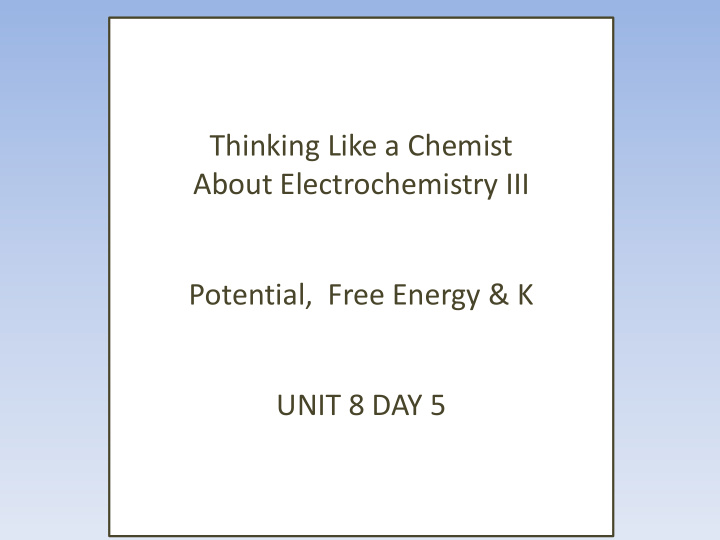



Thinking Like a Chemist About Electrochemistry III Potential, Free Energy & K UNIT 8 DAY 5
What are we going to learn today? Determine Voltage in Electrochemical Cells Containing Different Concentrations of Reactants Relationship between ΔG, E, and K
Quiz: Clicker Question 1 Ampere is the same as: A. 1 Joule/Coulomb B. 1 Joule/second C. 1 Coulomb/second D. 1 Coulomb/mole e -
Quiz: Clicker Question Faraday ’ s Law of electrolysis: The amount of product formed or reactant consumed by an electric current is stoichiometrically equivalent to the amount of electrons supplied. How many moles of Al (s) can be produced from Al 2 O 3 if 5.0 mol of e - are supplied? A. 1.0 B. 1.7 C. 3.0 D. 6.0
Quiz: Clicker Question Given: 1 mol e - = 96,485 Coulombs 1 Amp = 1 Coulomb/sec How many hours is required to plate 35.0 g of copper metal from 0.5 M CuSO 4 (aq) by using a current of 3.0 A? A. 3.5 hr B. 7.0 hr C. 10 hr D. 13 hr
Work on Learning Activity….. Video to remind you of the experiment: https://www.youtube.com/watch?v=fJwkxD_wZvk
Poll: Clicker Question Activity question #2: From the given thermo data, what is the value of ∆G ° ? A. -416 kJ/mol B. +416 kJ/mol C. -1159 kJ/mol D. +1159 kJ/mol
Poll: Clicker Question Activity question #4: From the given computed value of ∆G ° , what is the value of K? A. Enormous B. Infinitely small C. 1
Poll: Clicker Question Activity question #6: From the given standard reduction potential data, what is the value of E cell ° ? A. -1 V B. +1 V C. -2 V D. +2 V After completing this question, go back and read the “introduction” paragraphs at the top of the activity!
Relationship between E and ∆G ∆G is energy E is electrical potential Electric work (energy) = -(charge x potential) work = -charge X E ∆G = work max ∆G = - charge X E max From now on we ’ ll know the Potential we calculate is the theoretical maximum Real world never actually that good
Relationship between E and ∆G ∆G = - charge X E What is the charge? charge = n X F n is number of moles of electrons (per mole rxn) F is the charge of one mole of electrons F = 96,485 C (Faraday's Constant) ∆G = - nFE
What did we learn today? Calculate the cell potential for a nonstandard cell. Describe fully the relationship between the free energy and the cell potential. Describe fully the relationship between cell potential and the equilibrium constant. Explain thermodynamically the operation of a concentration cell, and be able to predict the concentration in the cell based on the cell potential. Understand the relationship between charge delivered or produced and the amount of reactant used or product formed for both galvanic and electrolytic cells.
IMPORTANT INFORMATION LMs 36 & 37 Reminder: Directions for applying to be an undergraduate learning assistant are on course webpage!
Recommend
More recommend